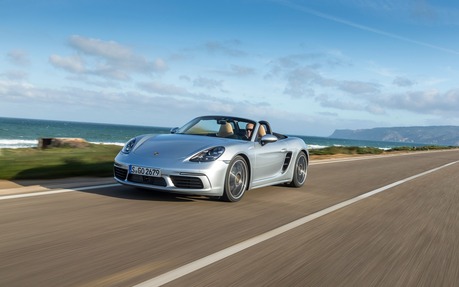2017 Porsche 718 Boxster: More Power, Fewer Thrills
For the 2017 model year, Porsche is tacking on the number 718 to the Boxster and the Cayman coupe. The reason is elementary: it creates a more direct link between the 718 Boxster and 718 Cayman with its most emblematic model – the 911 Carrera. Why 718, you ask? It’s a reference to the Porsche 718 that burned up racetracks in the 1950s.
Does it sound right?
It’s not the new moniker that’s grabbing all the headlines, nor is it the fact that the car has been completely redesigned and doesn’t share a single body element with the previous version (except the trunk lid, windshield and top). Rather, it’s the radical transformation in the engine compartment and the new vocal signature that comes along with it.
- Also: 2017 Porsche 718 Boxster: We're Driving it This Week
- Also: 2017 Porsche 718 Boxster: Singing to the Tune of a New Engine
By swapping out the naturally aspirated, flat-six engines for a pair of turbocharged flat-fours, the 718 Boxster and 718 Boxster S gain both power and torque, making them even faster than they used to be. But these gains come at a cost: much of the thrill is gone because the deep, halting and husky engine sound doesn’t elicit the same emotional reaction as the old engine.
So the engine no longer waxes poetic, but complying with emissions regulations and fuel consumption standards meant something had to be sacrificed. Get used to it.
The 911 Carrera engines, but with two less cylinders
From a technical perspective, the new four-cylinder turbo engines – a 2.0-litre for the 718 Boxster and a 2.5-litre for the 718 Boxster S – are closely adapted from those of the recent 911 Carrera and 911 Carrera S, to the point that you can almost say that it’s essentially the same engine minus two cylinders.
Note that the 2.5-litre unit in the 718 Boxster S features technology that, until now, had only been used in the 911 Turbo engine: a variable geometry turbocharger that helps optimize the delivery of power and torque.
Torque, torque and more torque
Driving the 718 Boxster, you’ll immediately notice that acceleration is fiercer than before. You may even consider settling for this base version, whose 2.0-litre engine develops 300 horsepower.
The S cranks things up a notch with even more torque and power (350 horsepower), helping it sprint from 0 to 100 kilometres per hour in 4.2 seconds with the PDK dual-clutch gearbox and the Sport Chrono Package.
Even though the engines are turbocharged, accelerator response is every bit as lively as with the naturally aspirated engines, thanks to the magic of “pre-charging” courtesy of the turbocharger and by the Dynamic Boost function, included here just like it is in the 911 Turbo.
Basically, this function maintains the turbo’s pressure even when the driver eases off the accelerator to slow down before taking a turn, to then immediately deliver the power once the driver accelerates out of the turn. Believe me, it’s very efficient. There are no complaints about performance – these 718 Boxsters are much livelier than the previous versions.
Steering borrowed from the 911 Turbo
Sharp dynamics have consistently been the Boxster’s strong suite. This remains true for the new versions, which feature optimal weight distribution and very balanced handling.
In the makeover, the engineers chose to use rims that are a half-inch larger in the back with tires that are larger as well, while the car’s tail end is even more glued to the pavement than before. The front end is also more spirited thanks to steering taken from the 911 Turbo that is 10% more direct than that of the previous version.
With the addition of the optional Sport Chrono Package, you can choose from four driving modes: Individual, Normal, Sport, and Sport Plus. The car then instantly adjusts its personality.
Life on board
As usual, the passenger compartment is meticulously finished and ergonomics are flawless. Like the recent 911 Carreras, the 718 Boxster gets the very latest version of the PCM telematics system with a seven-inch colour touchscreen. Add the Connect option to link your smartphone wirelessly to the exterior antenna, providing you with an iPod-compatible USB interface on the central console and give you Apple CarPlay with Siri voice command and the Porsche Car Connect system.
As is always the case, small modifications made to each of the elements of the car make for a seriously improved driving experience. But in the case of the new 718 Boxster and 718 Boxster S, the exception is the less evocative sound of the new turbocharged engines.
| Test drive report | |
| Test model | 2017 Porsche 718 Boxster |
|---|---|
| Trim level | Boxster S (PDK) |
| Price range | $63,900 – $81,660 |
| Price as tested | 81 660 $ |
| Warranty (basic) | 4 years/80,000 km |
| Warranty (powertrain) | 4 years/80,000 km |
| Fuel economy (city/highway/observed) | 9,5 / 6,0 / N/A L/100km |
| Options | Sport Chrono Package, PASM chassis, 20-inch alloy wheels |
| Competitive models | N/A |
| Strong points |
|
| Weak points |
|
| Editor's rating | |
| Fuel economy | 13% better fuel consumption than the previous versions. |
| Comfort | Comfortable in “normal” mode. |
| Performance | 300 horsepower for the basic version and 350 for the S: that’s not far from the numbers for the 911 Carrera circa 2004 to 2012. |
| Infotainment | New, more user-friendly version of the infotainment system with factory-standard Apple CarPlay. |
| Driving | Top-notch with the S, but the basic version is nothing to shake a stick at either. |
| Overall | More dynamic, more efficient, more user-friendly but relatively less thrilling. |
